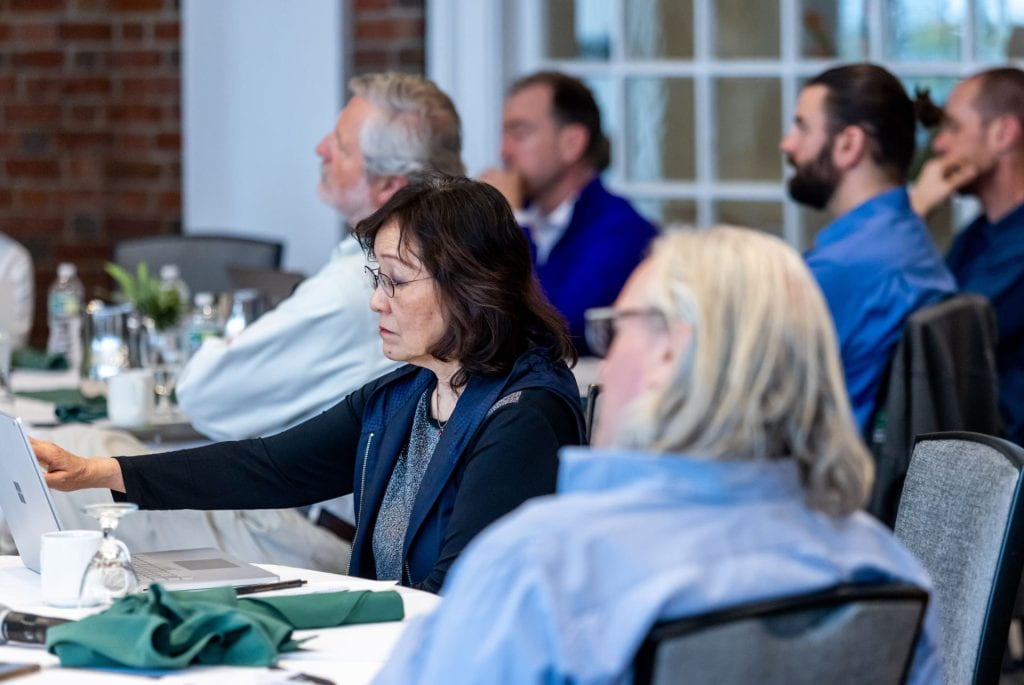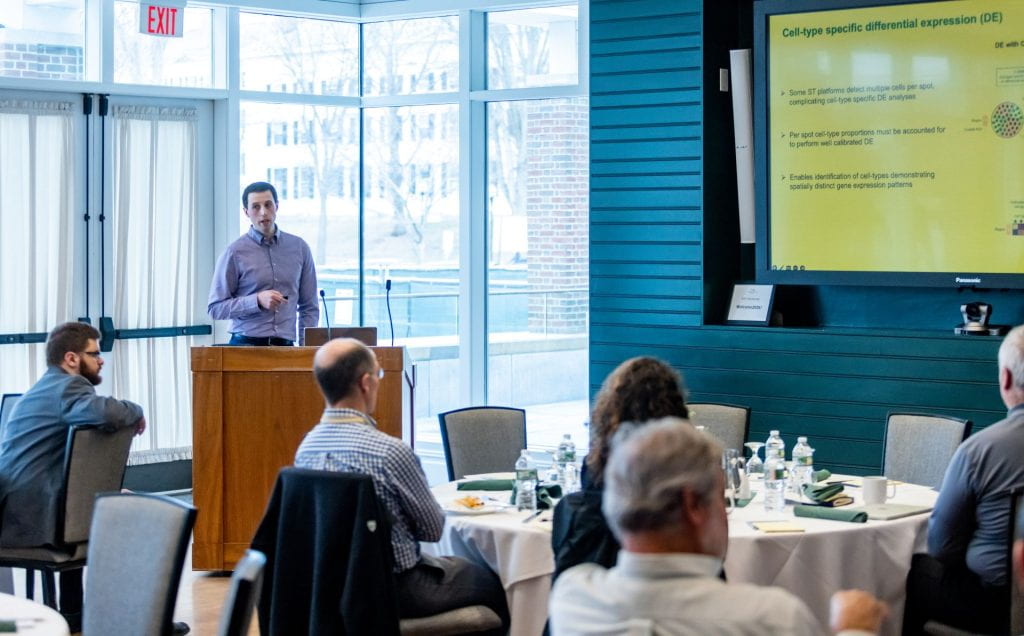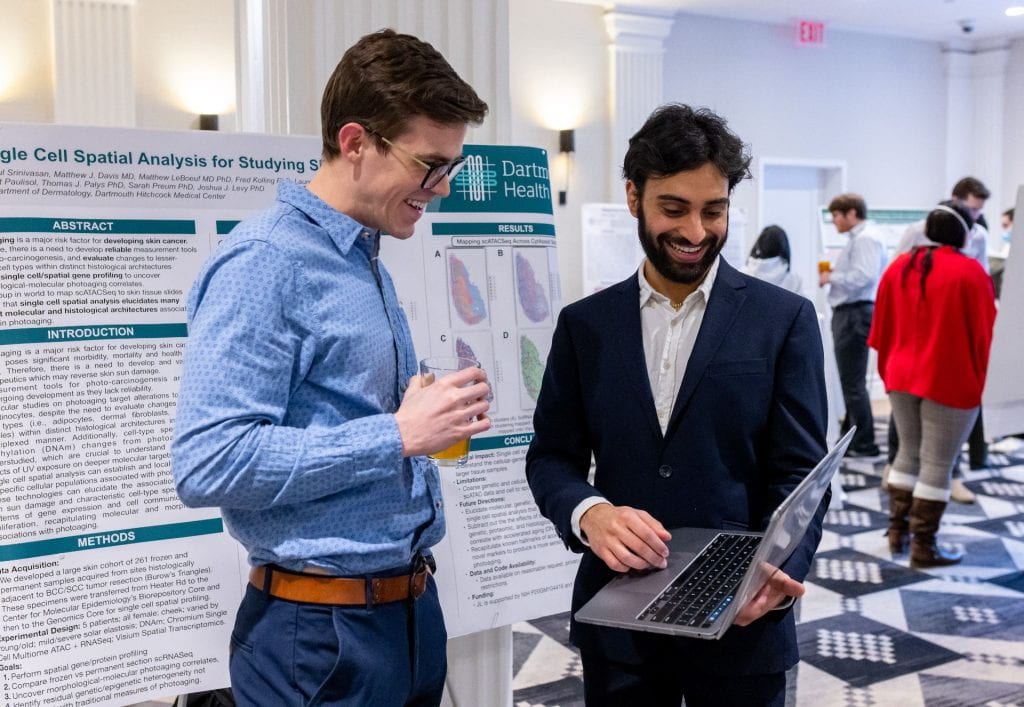photos: Lars Blackmore
On April 5th, 2023 the Center for Quantitative Biology held its annual meeting at the Hanover Inn in Hanover NH. The meeting is part of an annual review of the COBRE grant by the External Advisory Committee, but also an opportunity for members of the center and the larger community to get together, share their work, and make new acquaintances over breakfast or a glass of wine.

Introduction and Update on Center for Quantitative Biology

Dr. Whitfield presented a center overview, highlighting the successful graduation of four project leaders, Drs. Matt Mahoney, Feng Fu, Rob Frost and Sladjana Skopelja-Gardner. Drs. Mahoney and Fu rotated off the COBRE in 2022. Also highlighted were our four new research project leads, Drs. Siming Zhao, Britt Goods, Josh Levy and Li Song, recruitment of two new faculty members and ongoing searches in the Department of Biomedical Data Science/Center for Behavioral Health, Department of Molecular and Systems Biology, Thayer School of Engineering and the Department of Microbiology and Immunology.
CQB has had very productive pilot projects with a current application submitted for EAC review. Both Single Cell Genomics and Data Analytics cores have been extremely successful with increasing usage and customer satisfaction. Supplements and grants over the last several years exceed $8 million dollars. SARS-CoV-2 Surveillance project continues to make a significant impact on public health at Dartmouth College and aids in overall public health measures in New Hampshire.
Project Summaries

“Neutrophil-mediated pathways of kidney injury in lupus nephritis”
Project Lead: Sladjana Skopelja-Gardner
Dr. Skopelja-Gardner presented a nice overview of systemic lupus erythematosus (SLE), explaining how UV light triggers skin disease and exacerbates kidney disease. Her presentation described how ScRNA-seq of enriched glomerular and tubular cells help define cellular subsets and differential expression of renal tissue injury from UV light. She showed which kidney structural cells are injured after skin UV exposure and tissue remodeling pathways activated in glomerular stromal and endothelial cells. Using Deep Neural Network Analysis, courtesy of Dr. Mahoney, the ScRNA-seq data indicates acute glomerular injury even when no histopathology is observed by a pathologist.
Dr. Skopelja-Gardner continued her presentation showing how skin exposure to UV light affects neutrophil interaction with kidney structural cells. She concluded that UV light recruits CD177high neutrophils to the kidney and activates neutrophils across clusters to increase chemotaxis and adhesion. There is ongoing spatial transcriptomic analysis of Lupus Nephritis kidneys to determine if neutrophils mediate flares in SLE patients with concurrent skin inflammation.
“Mapping the impact of sex hormones on macrophage fates and functions”
Project Lead: Britt Goods

Dr. Goods work addresses unmet needs in reproductive health and immunology by applying and developing systems biology tools across biological scales. Her lab aims to solve problems surrounding macrophage fates and functions, non-hormonal contraceptives and identifying drivers of health and disease. Her presentation centered around macrophages and the impact of sex hormones impacting their function. She detailed the experimental approach for generating human inflammatory (M1) and anti-inflammatory (M2) macrophages in culture. After exposure to estrogen, her data showed a pronounced alteration of the global transcriptome for differentiated macrophages, more pronounced in M1. She will continue to focus on understanding the impact of estrogen on differentiation of cells in tissues.
Dr. Goods continued her presentation on the need for novel, female-targeted, non-hormonal contraceptives as part of the Ovarian Contraceptive Discovery Initiative (OCDI). Her experimental design pairs scRNA-seq data and spatial transcriptomics data from mice to provide a comprehensive picture of cells in whole ovaries. Spatial analysis of cells in tissues showed mesenchymal cells distributed across the ovary, several types of luteal cells and clear demarcation of granulosa cell subsets.
“Gene regulation and dynamical efficacy in antibiotic responses”
Project Leader: Daniel Schultz
Dr. Schultz provided an overview of predicting the evolution of antibiotic resistance. He showed regulation of the E. coli tetracycline resistance tet operon evolves in complex environments and can be lost in fast-changing drug regimens. He presented data on how induction of the wild type mexXYZ multidrug resistance mechanism in P. aeruginosa is slow, but once in the lung it acquires mutations to speed up the response. He also showed how, by understanding the effect of regulatory pathways in the resistance phenotypes of microbes, we can devise treatment regimens that address specific drug-resistance profiles.
“Predicting TCR and BCR specificity to microbiomes by massively mining RNA-seq samples”
COBRE Research Project Candidate: Li Song
Dr. Song presented a brief overview of his proposed CQB project to develop novel methods for microbiome detection and immune repertoire reconstruction from various RNA-seq data. He also discussed his plans for creating databases for the microbiome and immune repertoire in various clinical conditions, leveraging the databases to predict the binding specificities of user provided TCRs and BCRs using statistical modeling. Lastly, he will create open-source packages and web portals to facilitate the TCR/BCR specificity annotation in biological studies.
“Revealing the impact of tryptophan metabolism on host-microbe and microbe-microbe interactions in the gut”
Pilot Project Leader: Ben Ross
Dr. Ross provided a brief overview of the gastrointestinal (gut) microbiota and health and the impact of tryptophan metabolites on a host. His pilot project looks at how tryptophan metabolism by human gut bacteria impacts gut microbiome composition and function. He plans to complete initial experiments by the end of May 2023, with a goal of writing an initial manuscript summer 2023.
“Predicting colon cancer metastasis through spatial molecular characterization of the tumor immune microenvironment”
Project Leader: Josh Levy
Dr. Levy presented an overview of colorectal cancer (CRC) and the work he has done to create a low-cost spatial molecular test to infer CRC recurrence risk. He discussed the challenges with lymph node exam and how assessment can hamper recurrence risk assessment. Developing AI technologies which can study the tumor immune microenvironment as a low-cost recurrence risk assessment. His preliminary results provide for possible use of his model in multi-center clinical trials.
“Computational approaches to studying somatic mutations in cancer”
Project Leader: Siming Zhao
Dr. Zhao began her presentation with the central question in human genetics. What are the disease-causing variants and how do they cause disease? She provided an overview of her lab’s work on how germline background affects somatic mutation, what are the functional variants, and which contribute to disease.
Core Updates

Data Analytics Core
Core Co-Directors: Shannon Soucy & Owen Wilkins
Dr. Owen Wilkins provided an overview of the progress made by the Data Analytics Core over the last year. The core has experienced consistent growth of users and experienced a strong need for additional pipelines and services that focus on spatial transcriptomics and long-read data analysis. Workflows in development include single cell multiome and spatial omics – Visium + MERFISH. Educational developments included 3 annual workshop series, creating NIH training modules on Google Cloud and the build of a single cell analysis workshop.
Single Cell Genomics Core
Core Director: Fred Kolling
Dr. Kolling discussed new resources available through the Single Cell Genomics Core, and the ways in which those resources are being used. He discussed some of the challenges the core might face going forward as well as well as new technologies and techniques being developed that the core might consider in the future.
Supplements
SARS-CoV-2 Surveillance in Northern New England- COBRE Supplement
Dr. Joel A. Lefferts and Tim Sullivan presented on the COBRE supplement. Supplement goals are being met for the number of samples sequenced and data is being uploaded to public databases. The group is currently in the process of looking at correlations from sequencing data to ascertain if there are lineages different in NH/VT vs New England, Northeast, US. They are also analyzing the data for correlations of multiple collections from the same patients. They hope to discover helpful information on post-acute COVID syndrome (long COVID) and the correlation of lineage vs age, sex, region, symptomatic vs asymptomatic, source (clinical testing vs campus screening).
Poster Session and Reception
The evening ended with a poster session and reception where attendees could learn more about student projects and chat over drinks and hors d’oeuvres.

